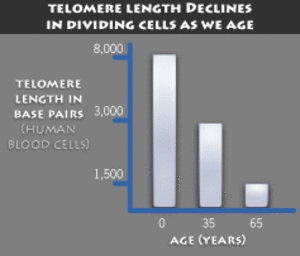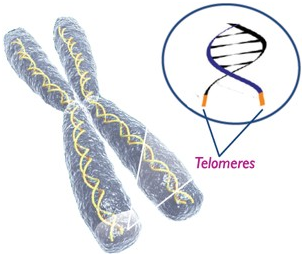Three Months to Longer Life

It’s all about telomeres, that DNA on the tips of chromosomes. Telomere length is the marker for longevity – the shorter they become, the shorter your life. Good news is – you can protect and even extend them, and thus, your life.
 IT’S NOT a common term in the public sphere, but it won’t be long before everyone has heard about telomeres and knows that they are a biological marker for longevity.
IT’S NOT a common term in the public sphere, but it won’t be long before everyone has heard about telomeres and knows that they are a biological marker for longevity.
Before I describe what Telomeres are, let’s entertain a short biology lesson.
We all start out as a single cell which then divides an extraordinary number of times to form what you observe in the mirror subsequent to an estimated ten trillion divisions. In each cell nucleus there are chromosomes, which carry the genetic information that comprises you. If your chromosomes shrank every time a cell divided, after a few trillion repetitions, any functioning genes located near the ends of the chromosomes would be lost, and there wouldn’t be much genetic material to pass off to your offspring.
So, why aren’t the chromosomes diminished into oblivion?
The answer: Telomeres, because Telomeres are the short DNA sequences on the end of chromosomes that protect them. They can repeatedly do this due to an enzyme called telomerase which can extend the repeating telomere sequence.
Problem is that telomerase is absent from most adult cells, so a bit of the telomere sequence is lost every time a cell divides. Once its telomeres become too short, a cell loses its ability to divide and either ages or self-destructs. 
(For those with the interest, you can read and step yourself through an animation that explains telomeres, and if video is more compelling, Nobel winner Dr. Elizabeth Blackburn presents to a Google audience everything you never knew you didn’t know about telomeres, which you can watch at the bottom of this post.)
Now that you know something about telomeres, let’s address how you can protect, or even extend the length of yours. For this, we turn to a study conducted by renown heart disease researcher and medical doctor, whose office is just down the street from my home, Dr. Dean Ornish.
First, know that the easiest way to extend telomere length is by increasing the activity of the enzyme telomerase.
Dean Ornish’s study took 30 men and put them on the typical Ornish program that he effectively employs to reverse heart disease:
- A diet rich in fruits, vegetables whole grains, legumes & soy.
- Fat content of their diet limited to 10% of the total calories.
- Minimal refined sugars.
- Vitamin supplements and fish oil.
- Moderate exercise – 30 minutes a day. (Read How Exercise Slows the Aging Process.)
- An hour of a daily stress reducing activity, like meditation or yoga.
Here were the results:
After the three month program, blood levels of the participants’ enzyme telomerase were 29% higher than when they began, and 24 out of 30 men showed significant increases in their telomerase levels.
That’s stunning!
As we get older, there’s a growing desire to find the fountain of youth. We hope that some special supplemental vitamin or drug will do the trick, thus relying on the scientific genius and efforts of someone else. And yet, this capability is right within our own grasp.
I tell you this – it won’t elude my grip.
Now settle back and let a Nobel prize winner show you how to live longer:
Last Updated on April 11, 2023 by Joe Garma


